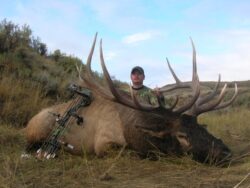Elk hunting is hard! You need to head into the high mountains, thin air, predator filled forests, and put in your time. If it isn’t, you are doing it wrong, or hunting on a preserve.
Elk keep a schedule. They are not as easy to pattern as deer, but they do move according to needs and wants. Sunrise is the time when elk hunting gets started. This is when the elk are the nosiest. They can be heard moving and calling. This goes on until mid-morning. The elk usually move upward and end up on a north facing slope or ridge. Bugle to locate a bull then head upwind and get as close as you dare. Cow calls will be important.
Instead of hunting low in the morning, head high and anticipate where they will end up. This takes scouting.
Mid-Day hunting means look for where elk are bedded. Since they eat tons of grasses and forbs, they need time to digest. Cows will generally lay down while herd bulls chase off satellite bulls. This is my favorite time. Make sure that you can smell the elk and can stealth fully shirt the edges. Many hunters take a break at this time. If the wind is in your face, slip in tight to a bedded herd and set up for a bull.
This is also a good time to hang out near water or wallows. This is how I tagged a bull at 1:00 in the afternoon. A tree stand was placed over a wallow before the season. I took my break 15 feet up. The bull slipped in and gave me a perfect 15-yard shot, walking right under my stand. I had also placed a cow decoy on the other side of the clearing.
Late afternoon to sunset is a good time to hunt but get closer to camp. Elk will rise and shine and begin heading to where they will be feeding. A water stop is often on the way. You often hear bulls’ bugle when they rise. If they wind a cow in heat, the action can be quick. If you are still alongside the herd, get ready. Soft cow calls are helpful. If you are on water or wallows, stay alert.
Just before dark, elk will enter the area or field where they plan to feed. Look for previous sign and set up downwind. Look out for bears. They are hunting too.
If you are nearing camp and getting a shot is unlikely, bugle and see if you can get a general idea of where to go the next day.
Hunting the same area daily will reduce your odds. If you spook a herd, they will travel over 10 miles into a fresh area. Generally, I suggest that you give yourself a window of 10 days to tag an elk. Sure, you may hook quick but that has not been my luck. For newer hunters, it may take 7 encounters before they settle down and get a decent shot. You may only get one prime opportunity a season so take the time to practice, plan, and be prepared.
Bugle, chirp, chirp!
Montana Grant